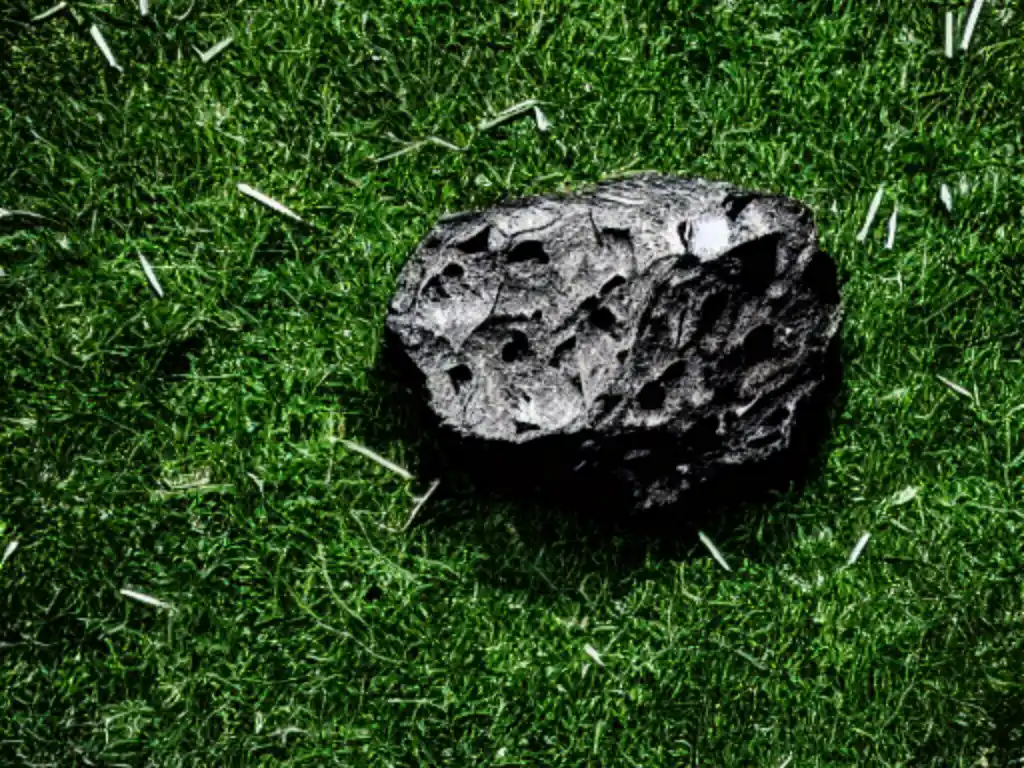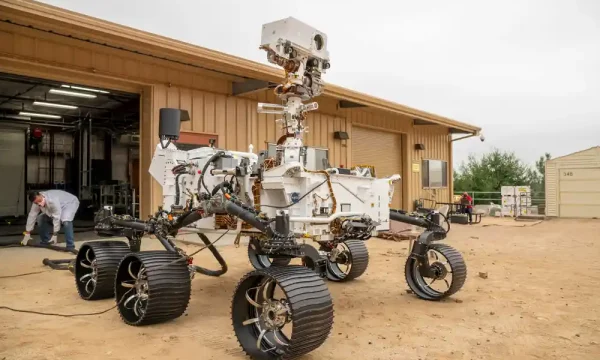
50 Questions & Answers About Perseverance Mars Rover
Last Updated: November 18, 2022
You may have heard of the Mars 2020 mission that was launched in July 2020. This NASA-commissioned mission is a rather special one because it was designed with the intention to look for signs of ancient life. Such a lofty goal requires state-of-the-art technology and that is exactly what the perseverance rover is: a mobile space laboratory equipped with the latest in cutting-edge scientific equipment.
In this article, we’ll answer some burning questions you may have about this incredible machine.
1. What is the perseverance rover?
The Perseverance rover is a remotely operated robotic vehicle designed to search for signs of ancient life, collect samples of Martian rock and soil, and gather data in preparation for human exploration of the Red Planet. The rover is the latest in a long line of Mars rovers that includes Sojourner, Spirit, Opportunity, and Curiosity.
2. What will the perseverance rover do?
The primary goal of the mission is to search for signs of ancient Martian life. To that end, the rover is equipped with a suite of scientific instruments, including a high-resolution camera, a laser spectrometer, a ground-penetrating radar, environmental sensors, a coring drill and a sample handling system.
Using these tools, Perseverance will perform a series of experiments designed to study the Martian climate, geology and environment. Additionally, the rover will collect samples of Martian rock and soil for return to Earth at a later date.
3. What is the difference between the perseverance rover and other Mars rovers?
The Perseverance rover is larger and more capable than any of its predecessors. The rover is also equipped with more advanced scientific instruments than any other Mars rover. More importantly, it is the very first rover that was specifically designed to look for traces of past life on another planet’s surface.
4. Why is perseverance important?
The Perseverance rover represents a significant step forward in our ability to study other planets for signs of life. Additionally, the data and samples collected by the rover will help us better understand the Martian climate and environment. Can you imagine how incredible it would be to discover that life happened on another planet? Our understanding of life and the universe would be changed forever.
5. What is the purpose of the perseverance rover?
Perseverance’s main purpose is to find signs of ancient life on Mars. Scientists hope that the Martian soil contains traces of organisms that might have lived on the red planet a long time ago. Perseverance will perform some basic soil testing in various locations in the hope to find any clues about Mars’ history.
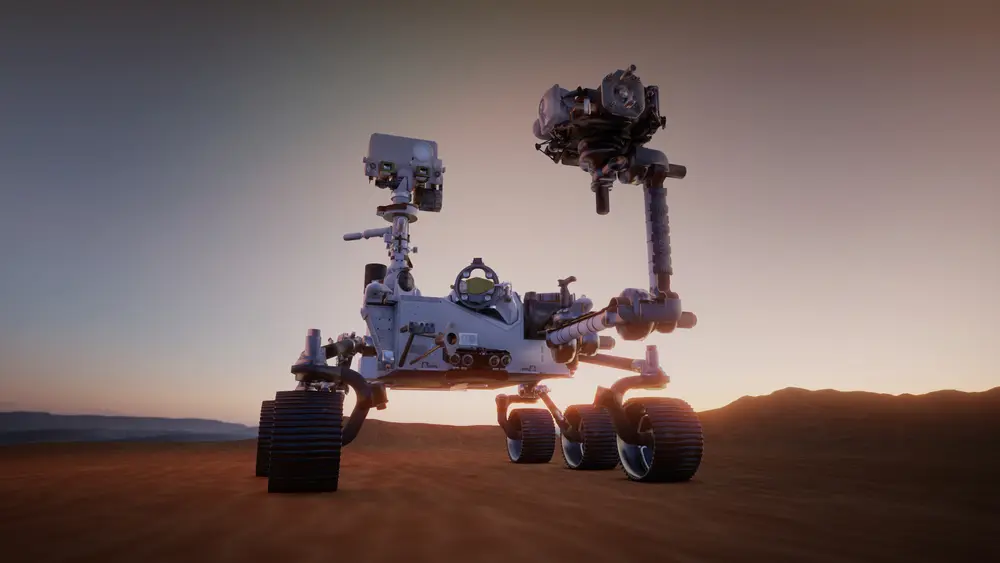
Perseverance, also known as Percy, is exploring the martian surface.
6. How could perseverance help us understand Mars?
Perseverance’s discoveries can help us understand the red planet’s history. If signs of ancient life are found, it would suggest that Mars was once habitable for microbial life. The rover can help understand the planet’s geological features better as well as the different challenges that future colonizers may face.
7. What are some of the challenges faced by perseverance?
Mars is a dusty, cold and hostile environment. The rover will have to endure dust storms, freezing temperatures and high levels of radiation. Additionally, the rover’s solar panels will need to be kept clean in order to generate enough power to operate. The Martian terrain is also very rocky and rugged, which could make it difficult for the rover to move around or damage one of its 6 wheels.
8. Who built perseverance?
The rover was designed and built by NASA’s Jet Propulsion Laboratory. JPL is a division of the California Institute of Technology. The team includes scientists, engineers, and technicians from around the world. Some of the key team members include:
- Project Manager Art Thompson
- Project Scientist Ken Farley
- Chief Engineer Soren Madsen
- Robotic Operation Chief Frank Hartman
- Program Executive George Tahu.
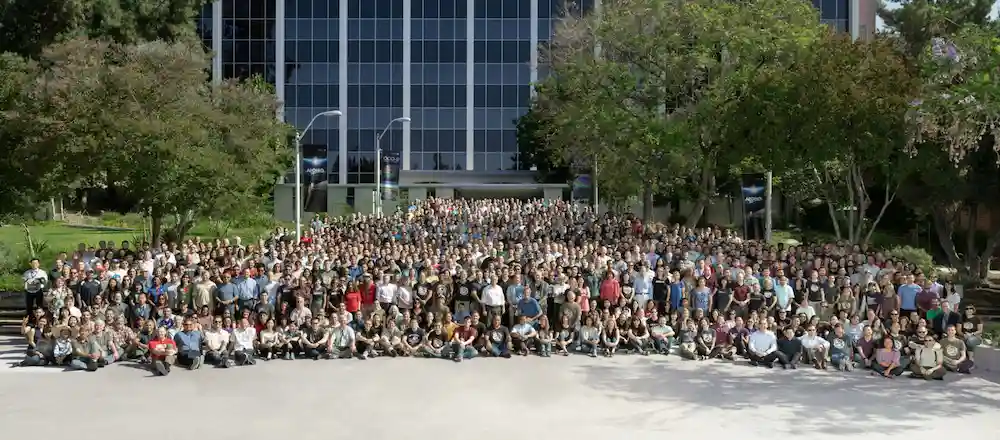
Every person that has worked on the 2020 mars mission is in this picture. What an awesome bunch of people!
9. Who named the perseverance rover?
The rover was named by a 7th-grade student from Colorado, Alex Mather. The name was chosen through a nationwide contest that invited students to submit name ideas along with essays about why the rover should be named that. Alex’s entry was selected out of the 28,000 entries.
In his essay, he explained: “We are a species of explorers, and we will meet many setbacks on the way to Mars. However, we can persevere. We, not as a nation but as humans, will not give up.”
10. How much did it cost to build the rover?
In order to make this mission a reality, NASA has invested $2.7 billion in this ambitious project. According to Planetary.org, the costs include $2.2 billion for spacecraft design, development and manufacturing, as well as $243 million for launch services and $300 million for mission operations.
Even though this is a very costly project, the amount of money is still significantly lower than some of NASA’s other high-profile missions such as the James Webb Space Telescope which cost over 10 billion dollars.
11. What tools were installed on perseverance?
The rover is equipped with 7 science instruments to help it carry out its mission
- Mastcam-Z: A high-definition zoomable camera that will take pictures and videos of the Martian surface.
- SuperCam: A rock-zapping laser that can identify the chemical composition of rocks and soil from a distance. This is the main instrument that was designed to detect the presence of organic compounds in rocks and regolith.
- PIXL (Planetary Instrument for X-ray Lithochemistry): An X-ray instrument that will search for minerals that might be associated with past life on Mars.
- SHERLOC (Scanning Habitable Environments with Raman & Luminescence for Organics and Chemicals): A Sherlock Holmes-inspired instrument that uses an ultraviolet laser to look for organic compounds and minerals that might be related to past or present life on Mars.
- MOXIE (Mars Oxygen ISRU Experiment): An oxygen generator that will produce oxygen from the carbon dioxide in the Martian atmosphere. This could be used in future missions to Mars to help astronauts breathe.
- RIMFAX (Radar Imager for Mars’ Subsurface Experiment): A ground-penetrating radar that will map the subsurface of Mars in 3D.
- MEDA (Mars Environmental Dynamics Analyzer): A suite of sensors that will measure the Martian environment, including temperature, wind speed, and radiation levels.
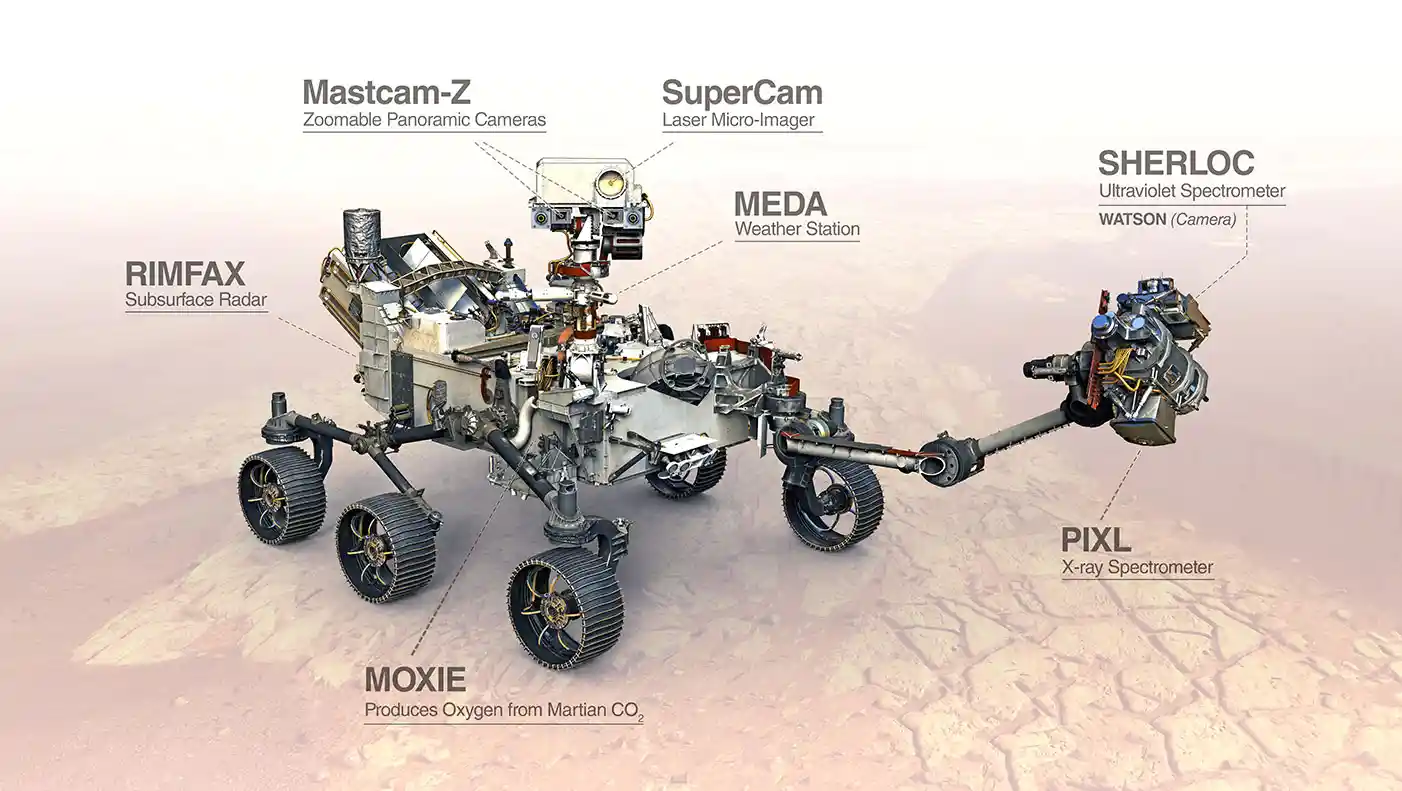
There are 7 state-of-the-art scientific instruments onboard Perseverance.
12. How long did it take to build perseverance?
We do not exactly know how long it took to build the rover. However, we can guestimate based on the different announcements that have been made by NASA officials. The Mars 2020 mission was first announced back in 2012 and we know that the rover has been through several rounds of testing before being launched into space. So, based on this information, we can estimate that it took 7 to 8 years to design, manufacture and test the rover.
13. Where was the perseverance rover manufactured?
The rover was built and assembled at NASA’s Jet Propulsion Laboratory in Pasadena, California.
The Jet Propulsion Laboratory is a division of the California Institute of Technology where some of the world’s leading experts in robotics and spacecraft design work. Some of the most notable spacecrafts that were built at JPL include:
- The Voyager probes
- The Cassini probe
- The Curiosity rover
14. What is perseverance made of?
The rover is made of high-strength aluminium alloy and titanium. These materials were chosen for their durability and resistance to harsh conditions on Mars. Additionally, Perseverance is fitted with many electrical wires and optical fibers that help the rover communicate and operate its different systems.
15. How big is the perseverance rover?
The rover is as big as a normal-sized car. The exact dimensions are:
- 10 feet long without the arm (3 meters)
- 9 feet wide (2.7 meters)
Perseverance is just as big as its predecessor Curiosity, which served as the main inspiration for its design. We have come a long way since the very first mars rover, Sojourner, which was rather small (650 mm long and 480 mm wide).
16. How tall is perseverance?
The rover is not that tall, even with its head all the way up. Perseverance stands at about 7 feet tall (2.1 meters). For reference, this is as tall as a basketball player or a Dromedary Camel.
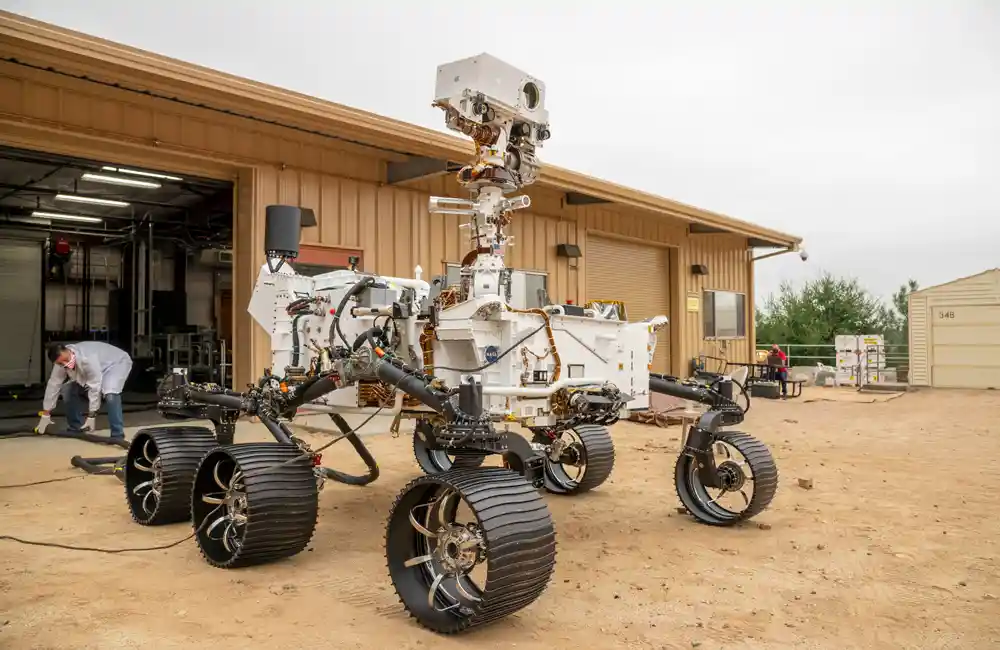
With its head fully deployed, the rover stands at about 7 feet tall.
17. How much does the perseverance rover weigh?
Perseverance is quite heavy and weighs 2,260 pounds (1,025 kilograms). This is about the same weight as a Greenland Shark, two grand pianos or a Black Rhinoceros. For comparison, the Curiosity rover weights 899 kg (1,982 lb) and the Opportunity rover weighed 180 kilograms (400 lb).
Keep in mind that the gravitational pull on the Martian surface is only about 38% of what we experience on Earth. On Mars, Perseverance weighs 854.93 lbs (387.74 kg). So, even though the rover is quite heavy, it will not have any trouble moving around on the Martian terrain.
18. How is the perseverance rover powered?
Perseverance relies on nuclear power (also known as Radioisotope power) to operate on the red planet. The rover is equipped with a 45kg power system known as a Multi-Mission Radioisotope Thermoelectric Generator (MMRTG) which converts the heat from radioactive plutonium-238 decay into electricity.
This type of power source has been used on many previous Mars missions, including the Curiosity rover. The MMRTG will provide about 125 watts of power to the rover, which is enough to operate all of its systems and keep its instruments warm during the cold Martian nights. This power system can last for 14 years.
19. How long will the perseverance rover be on Mars?
The rover’s mission is currently expected to last for one Mars year, which is about 687 Earth days. However, the rover is designed to operate for much longer than that. Granted nothing unexpected happens, like a giant sandstorm, or a wheel breaking on the harsh planet’s surface, but we may be able to get many more years of data and discoveries from Perseverance.
The Opportunity rover launched in 2003 was also supposed to have a short lifespan. However, the heroic little rover lasted for more than 14 years. Fingers crossed Perseverance will break that record!
20. Can the perseverance rover fly?
No, the perseverance rover cannot fly as it is not required for its mission. That being said, the rover did not land on Mars on its own. Enter Ingenuity, an experimental technology demonstrator that successfully completed the first powered, controlled flight on another planet.
The little 4-pound (1.8 kg) rotorcraft has a max flight time of about 90 seconds and can fly to a height of about 10 feet (3 meters). These experiments might give scientists new ways to explore the red planet in a more efficient way in the future.
Bob Balaram, Chief Engineer on the Ingenuity Project recently shared the goals of the future robotic helicopters sent to Mars, to offer explorers the 4Rs: reach, range, resolution, and robotics.
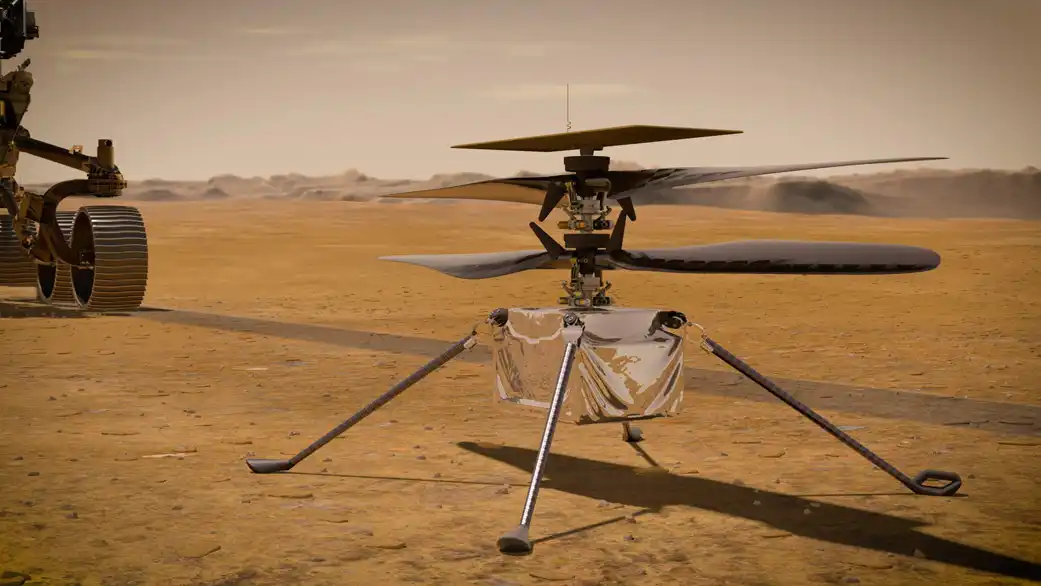
Ingenuity is the first aircraft to have successfully completed controlled flights on another planet.
21. Does the perseverance rover have solar panels?
No, solar panels would not have been practical for this mission as they require a lot of light to work properly and Mars is often covered in dust storms that could obscure the sun.
This lesson was learnt by NASA through the Opportunity rover’s demise, as its solar panels could no longer generate enough electricity to get it working after a global dust storm in 2018. Radioisotope power is a much more reliable source of energy for Perseverance.
22. When was the perseverance rover launched?
Perseverance was launched on July 30th, 2020 from Cape Canaveral Air Force Station in Florida, United States. The liftoff was live-streamed to millions of viewers around the world, eager to see the rover begin its long journey to Mars. The launch window for this mission was very short, as the planets have to be in alignment just right for a successful interplanetary transfer.
23. How did the perseverance rover get to mars?
Perseverance was launched on a United Launch Alliance Atlas V-541 rocket and spent several months travelling through space before finally touching down on Mars.
24. How long did it take perseverance rover to reach mars?
Just after launch, the spacecraft separated from the rocket. The spacecraft traveled at a speed of ~24,600 miles per hour (~39,600 kilometers per hour) and traveled ~300 million miles (~480 million kilometers). Perseverance’s journey took ~204 days, and during this time engineers adjusted the spacecraft’s flight path 5 times to ensure its speed and direction were optimized for a Jezero Crater landing
25. How did perseverance land on mars?
The spacecraft carrying Perseverance went through 7 minutes of terror as it performed an EDL (Entry, Descent and Landing) through Mars’ atmosphere at ~12,000 miles per hour (~19,000 kilometers per hour).
It then deployed a supersonic parachute to help decelerate the spacecraft. Next, retro rockets were fired to slow down the spacecraft and stabilise its descent, preventing a big impact. Finally, the rover was lowered to the surface of Mars on cables by what’s called a “sky crane” maneuver.
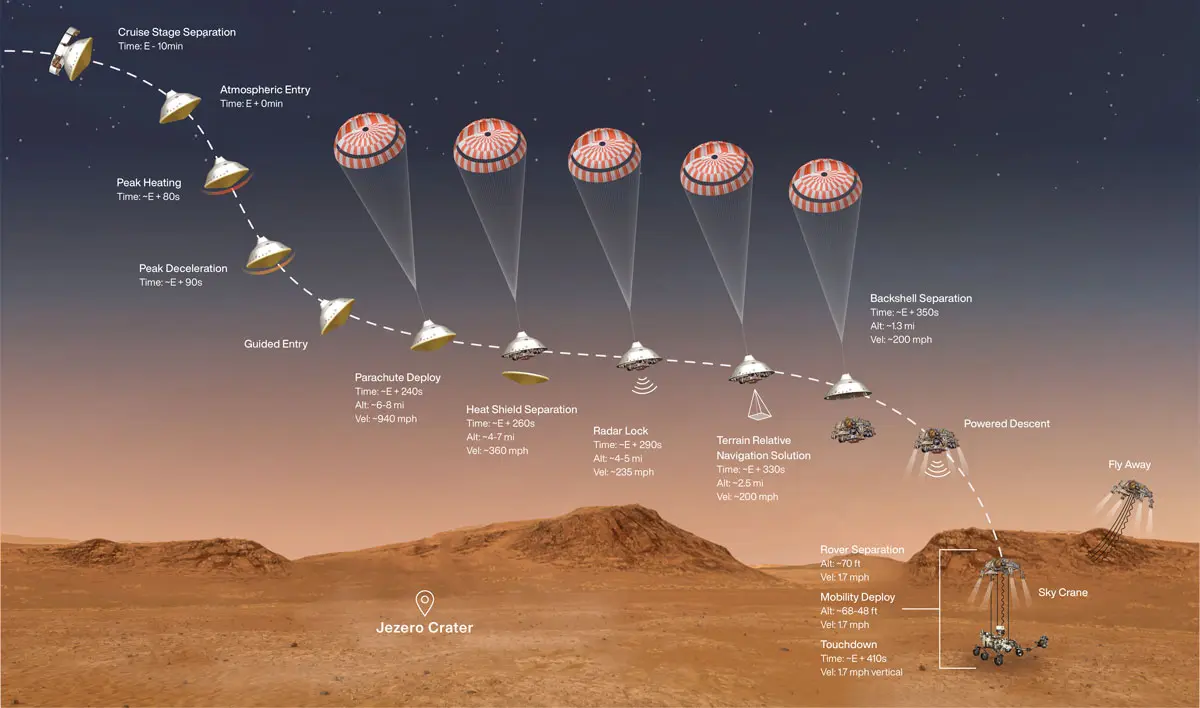
The above graphic depicts the step by step landing sequence of Perseverance on Mars. Image credit: NASA
26. Where did perseverance land on mars?
Perseverance landed in Mars’ Jezero Crater on February 18th, 2021. This picturesque location was chosen as it is thought to be the site of an ancient river delta, and therefore may contain evidence of past microbial life.
27. What time did perseverance land on mars?
The Perseverance rover was confirmed to have landed on the red planet at 3:55 p.m. EST (12:55 p.m. PST) on February 18th, 2021. For this historical moment, NASA had set up multiple live stream cameras, so that everyone could watch this amazing event unfold in real-time.
One of those live streams was set up from in the Mission Control room, allowing millions of viewers to watch and celebrate along with the engineers as they received signals back from Perseverance.
28. Is there a video of the Perseverance landing available?
Yes! Several cameras were fitted onto the spacecraft to capture different aspects of the landing. This includes footage from a belly-mounted camera that shows the rover’s descent under the parachute, as well as images and video from the “sky crane” lowering the rover to the surface.
You can relive this incredible moment in the below video:
29. What will the perseverance rover not do?
Despite the many goals for this mission, there are some limitations to what Perseverance can do. One of these is that it is not able to send the martian soil samples to Earth. Instead, it will deposit them in tubes using the “depot caching strategy” on the Martian surface, to be collected by a future mission and returned home.
I’m about to drop my first rock sample collection on the surface of Mars. I’m setting down the scientifically compelling, curated set of rocks at “Three Forks,” a spot just at the base of the river delta I’ve been exploring. #SamplingMars
— NASA's Perseverance Mars Rover (@NASAPersevere) October 28, 2022
More on plans: https://t.co/EzOe2n02PR pic.twitter.com/btOQOpeLyW
Additionally, due to its design, the rover is not able to climb very steep slopes or obstacles. This limitation is why the landing site in Jezero Crater was chosen, as it is thought to be mostly smooth and flat.
30. How does the perseverance rover communicate with the earth?
Perseverance is equipped with UHF antennas that send and receive X-band Radio Waves to and from Earth. Through this method of communication, the rover can send large data files, such as images and videos. These are sent via the Mars Reconnaissance Orbiter (MRO) which acts as a relay satellite.
Perseverance can also communicate with the DSN (Deep Space Network) ground stations on Earth directly. NASA has said that the data rate direct-to-Earth is roughly half as fast as a standard home modem.
31. How long is the perseverance rover life expectancy?
The mars 2020 mission is originally planned to last for one martian year (687 Earth days). However, with a design life of 10 years and robust hardware, the mission could potentially be extended. Unless something dramatic happens, we can remain optimistic that Perseverance could last for a decade. The Opportunity rover was active for 15 years before it was finally lost to the Martian dust storms.
32. How far did the perseverance rover travel so far?
During its interplanetary journey, Perseverance has travelled a total of 293.5 million miles (472.5 million kilometers). This is the equivalent of travelling to the Moon and back more than eight times!
As of November 2022, Perseverance has travelled a distance of about 8.14 miles / 13.1 km in 610 mars days.
33. Where is the perseverance rover right now?
The perseverance rover is currently located in Jezero Crater on Mars. You can track the current location of Perseverance using this interactive map from NASA. The map also displays the current position for the Ingenuity helicopter.
NASA provided some information about this interactive map:
“This map is composed of two layers: a high-resolution color map covering the initial exploration area inside Jezero Crater, and another true-color Northeast Syrtis regional map. The high-resolution base map was created with images from the HiRISE camera on NASA’s Mars Reconnaissance Orbiter, while the broader color base map is from the European Space Agency Mars Express High Resolution Stereo camera”
34. Who controls perseverance rover?
The rover is controlled by a team of engineers and scientists at the Jet Propulsion Laboratory (JPL) in Pasadena, California. The mission control center for Perseverance is located in the Space Flight Operations Facility (SFOF) at JPL. This is the same facility that was used to control the Curiosity rover.
You can follow the team’s progress on Twitter: https://twitter.com/NASAPersevere
35. How does the perseverance rover move?
The rover is equipped with six 50 cm diameter wheels that can turn independently. The wheels are made of thick and durable aluminum and have a slightly curved tread pattern to minimize slipping. The wheels were designed to be fault-tolerant, meaning that they can continue to operate even if one wheel stops working.
The rover also has a rocker-bogie suspension system that allows it to maintain stability while traversing over uneven terrain. This system was first used on the Mars Exploration Rovers Spirit and Opportunity. As the martian topology is varied and unpredictable, this system gives the rover greater mobility to explore a wider range of terrain in the safest way possible.
36. How fast was perseverance traveling?
During its journey through space, the spacecraft containing Perseverance was traveling at a speed of ~24,600 miles per hour (~39,600 kilometers per hour) and traveled ~300 million miles (~480 million kilometers).
Once it reached the martian atmosphere, the spacecraft was traveling at ~12,500 miles per hour (~20,000 kilometers per hour). When the spacecraft slowed to ~940 miles per hour (~1512 kilometers per hour) (~240 seconds after entry) the supersonic parachute was deployed.
This jet pack with eight engines pointed at the ground slowed the vehicle to 1.7 miles per hour (2.7 kilometers per hour) and finally, the skycrane lowered Perseverance on the ground slowly.
On the martian surface, Perseverance has a maximum traveling speed of around 0.1 mph (4.2 centimeters per second, or 152 meters per hour) which might sound rather slow but its actually quite fast for a rover. The Opportunity rover had a maximum speed of 0.05 mph (2 centimeters per second, or 72 meters per hour).
37. Can the perseverance rover take videos?
Yes! The rover is equipped with a high-definition Mastcam-Z camera that can take color and 3D images, as well as record video. The video capabilities of Mastcam-Z will allow scientists to not only see what the rover is seeing in real time, but also create “movies” of the Martian surface.
Perseverance is equipped with 23 cameras in total, which is more than any other interplanetary spacecraft. In addition to Mastcam-Z, the rover has a Hazcams (hazard-avoidance cameras), Navcams (navigation cameras), and SuperCam (a remote sensing instrument that can identify minerals and measure the chemistry of rocks).
Don’t expect to be able to watch live streaming video from Perseverance, however. The infrastructure to support HDTV Broadcasts on an interplanetary basis is quite not there yet and it would be very expensive to set up.
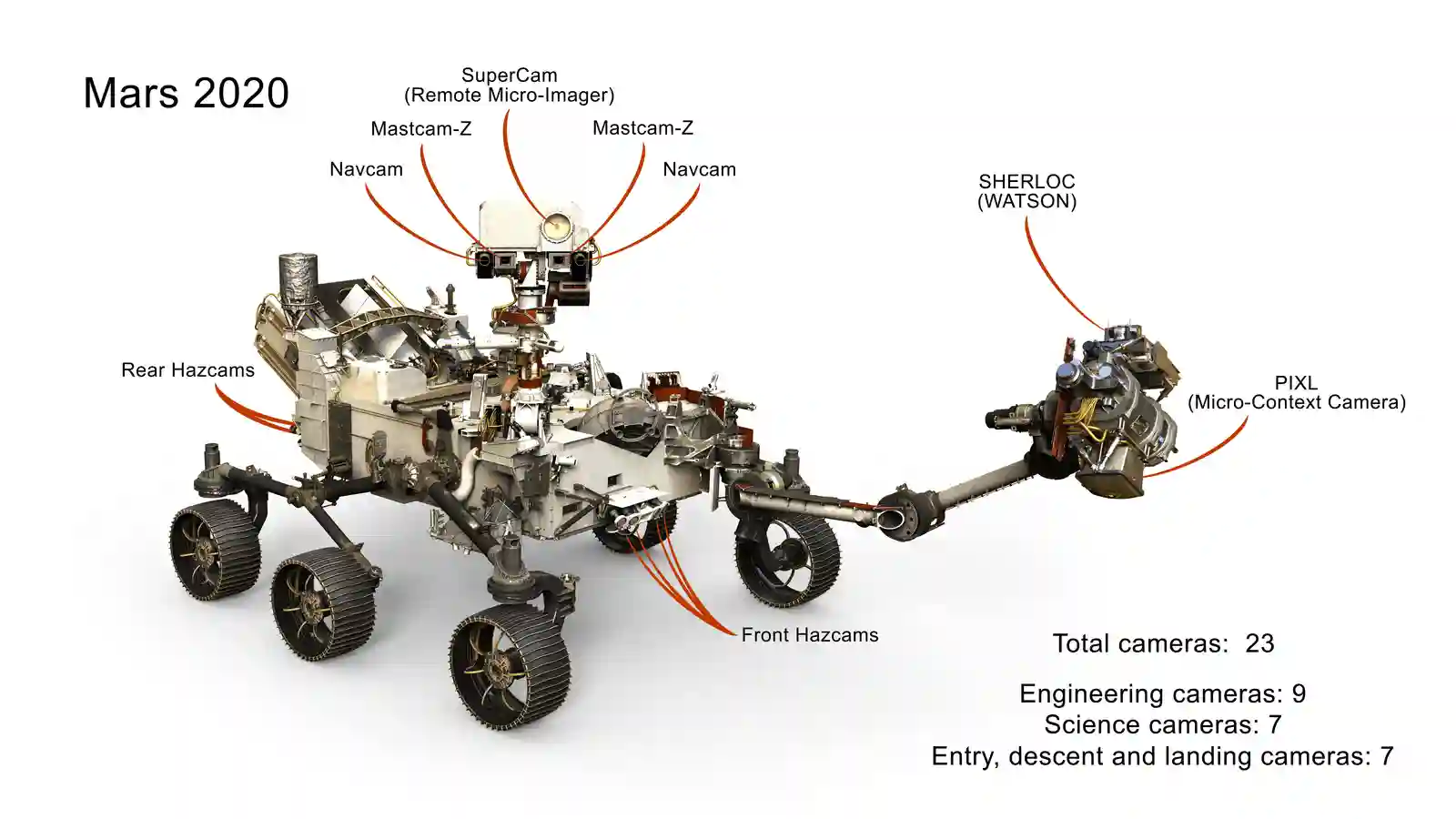
The above graphic depicts all of the cameras installed on the Perseverance rover. Image credit: NASA
38. Will perseverance rover return to earth?
I am afraid our brave went on a one-way trip. Perseverance is not designed to return to Earth and its mission is focused on exploring Mars and seeking signs of ancient life.
The rover has enough power to last for at least two earth years and possibly longer if the Martian climate cooperates.
39. Is perseverance rover still working?
Yes the rover is still operational as of today and is currently exploring the Jezero Crater on Mars. There has been no issue with communications and the rover is sending back a large amount of data for scientists to analyze.
The only mishap experienced by the rover in more than 600 sol is a rock that got stuck in one of the wheels. In June, NASA published an article entitled “Perseverance Has a Pet Rock!” explaining how a small rock is currently hitching a ride. The scientists have assessed that the rock, nicknamed “Rochette”, is not damaging the wheel so it is not a threat to the rover’s mobility and the martian mission.
40. What has the perseverance rover achieved so far?
- The rover has sent back over an enormous amount of data, including high-definition images and videos of the Martian surface.
- It has also collected samples of Martian rocks and soil, which will be returned to Earth by future missions.
- It has found organic molecules in Martian rocks, which are potential evidence for ancient life on Mars.
- Using MOXIE (Mars OXygen ISRU Experiment), it has generated oxygen from the carbon dioxide in the Martian atmosphere, which is a potential resource for future human explorers.
- It is helping scientists understand mars geology better by studying the Jezero Crater.
- All in all, the rover is successfully carrying out its mission and providing scientists with a wealth of information about Mars.
41. Is there a microphone on Perseverance?
Two microphones were installed on the rover, allowing scientists to record the sounds of Mars for the very first time in February 2021. You can listen to the audio recording on this page.
The microphones have captured wind gusts, which are surprisingly louder than expected, as well as some other ambient noise such as noises from the wheel moving and the arm extending.
42. Can the Perseverance rover climb hills?
Yes, it can! The six-wheeled vehicle is suitable for climbing slopes of up to 30 degrees of inclination.
The vehicle is also designed to overcome obstacles such as rocks or sand dunes that might be encountered while exploring Mars. That said, Jezero Crater is fairly flat terrain, so the rover won’t have to make any effort to climb hills and shouldn’t attempt it anytime soon.
43. Will curiosity and perseverance meet one day?
The two rovers are currently located in different locations on the Martian surface and thus will not be able to meet up. The closest they would ever get is about 3,700 km (2,300 miles) apart, so unfortunately it’s very unlikely for them to actually cross paths.
44. Will the perseverance rover visit the sky crane crash site?
No, the Perseverance rover is not scheduled to visit the sky crane crash site. With a cost of about $2.8 billion attached to this mission, scientists must concentrate solely on sites with high scientific value. The impact site is also far from any other point of interest, making a visit from the slow-moving rover unfeasible from an economic and scientific standpoint.
45. How does the Perseverance rover take selfies on Mars?
The rover is equipped with several cameras and a robotic arm. The cameras are used to take a series of overlapping images, which are then stitched together into a panorama. In addition, the robotic arm can be extended and angled in various positions to provide a different perspective which creates the illusion of a self-taken picture. for each selfie.
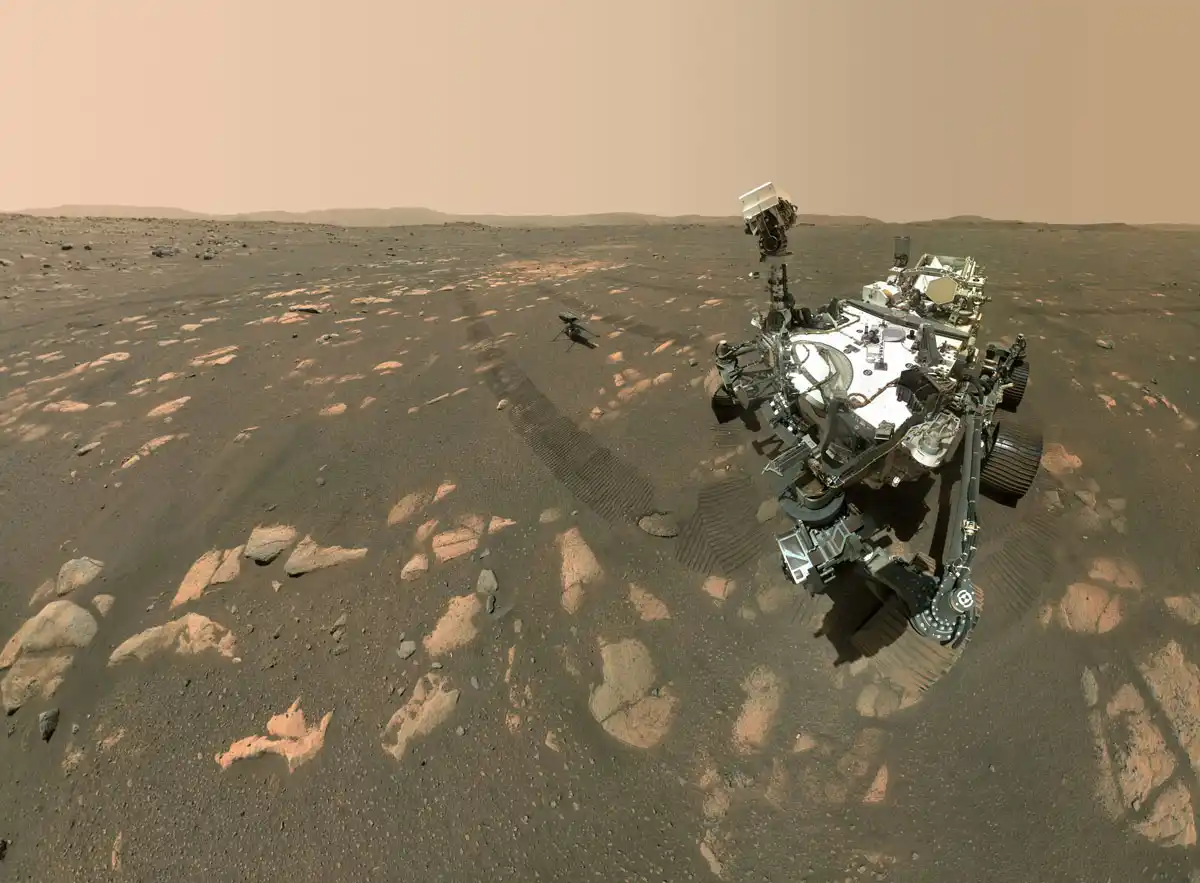
Perseverance took a selfie with Ingenuity in the frame.
46. Could perseverance become rusty?
No, the rover is made of titanium, aluminium and carbon fiber composites which are designed to resist rust in the dry Martian atmosphere. In addition, it has a protective coating on its surface to help protect against extreme temperatures and radiation.
47. Will there be a documentary about Perseverance?
NASA has collaborated with the National Geographic Channel to produce a documentary about the mission and its discoveries. The documentary, entitled “Built For Mars: The Perseverance Rover” features interviews with scientists as well as stunning footage of the Martian surface captured by the rover’s cameras. It is available for streaming on Disney+ here.
To keep up to date with future documentaries, be sure to regularly check out my list of fascinating space documentaries.
48. How can I keep up to date with Perseverance?
You can keep up with the Mars mission through several channels:
- The mission website: https://mars.nasa.gov/mars2020/
- Join the Mars newsletter.
- Follow the Perseverance Twitter account: https://twitter.com/NASAPersevere
- Keep an eye out for mission updates on the NASA YouTube channel.
49. How many rovers are currently on mars?
Currently, there are three rovers on Mars – the Curiosity rover, the Perseverance rover and the Zhurong rover. Curiosity has been operational since 2012, while both Perseverance and Zhurong arrived in early 2021.
50. When is the next rover going to Mars?
The Rosalind Franklin rover was set to launch in 2022 but missed its launch window due to a halt in collaboration with Roscosmos. ESA officials are currently in talks with NASA about taking part in the mission and have not yet announced when the rover will be sent to Mars.
It will be the first European mission to the Red Planet and is expected to drill into the Martian surface deeper than ever before to analyze rock samples in search of organic material.

I’ve been fascinated by space and astronomy from a very young age. When I’m not watching space-themed documentaries, movies or TV series, I spend most of my free time in my backyard admiring the planets and galaxies with my telescope.
Wow! There's more to read 🚀
This page is part of our collection of articles about astronomy. If you enjoyed the read, then you’ll love the following articles.
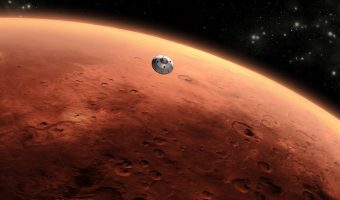


The dim, cold, windy world named after the Roman god of the sea takes the prize as the farthest planet from the Sun. What’s it like?
